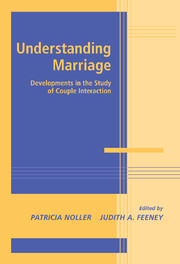Book contents
- Frontmatter
- Contents
- Contribitors
- Introduction
- SECTION ONE THE EFFECT OF COGNITION ON INTERACTION PATTERNS
- SECTION TWO UNDERSTANDING THE IMPORTANCE OF POSITIVE INTERACTION
- SECTION THREE COPING WITH DISAPPOINTMENT, CRITICISM, AND BETRAYAL
- SECTION FOUR POWER, CONFLICT, AND VIOLENCE IN MARITAL INTERACTION
- Introduction to Section Four
- 11 Demand-Withdraw Communication during Couple Conflict: A Review and Analysis
- 12 Approaches to the Study of Power in Violent and Nonviolent Marriages, and in Gay Male and Lesbian Cohabiting Relationships
- 13 The Communication of Couples in Violent and Nonviolent Relationships: Temporal Associations with Own and Partners' Anxiety Arousal and Behavior
- Marital interaction at important transition periods
- SECTION SIX Interventions for strengthening relationships
- Conclusions
- Index
- References
13 - The Communication of Couples in Violent and Nonviolent Relationships: Temporal Associations with Own and Partners' Anxiety Arousal and Behavior
Published online by Cambridge University Press: 25 July 2009
- Frontmatter
- Contents
- Contribitors
- Introduction
- SECTION ONE THE EFFECT OF COGNITION ON INTERACTION PATTERNS
- SECTION TWO UNDERSTANDING THE IMPORTANCE OF POSITIVE INTERACTION
- SECTION THREE COPING WITH DISAPPOINTMENT, CRITICISM, AND BETRAYAL
- SECTION FOUR POWER, CONFLICT, AND VIOLENCE IN MARITAL INTERACTION
- Introduction to Section Four
- 11 Demand-Withdraw Communication during Couple Conflict: A Review and Analysis
- 12 Approaches to the Study of Power in Violent and Nonviolent Marriages, and in Gay Male and Lesbian Cohabiting Relationships
- 13 The Communication of Couples in Violent and Nonviolent Relationships: Temporal Associations with Own and Partners' Anxiety Arousal and Behavior
- Marital interaction at important transition periods
- SECTION SIX Interventions for strengthening relationships
- Conclusions
- Index
- References
Summary
Interaction is the sine qua non of relationships; it is through communication that persons initiate, define, maintain, and terminate their social bonds.
—Baxter, 1985, p. 245Once violence occurs, the threat of further violence is always present, which may be viewed as a powerful form of psychological abuse.
—Cahn, 1996, p. 11When researchers merely count the overall levels of communication behaviors, they may not capture the intricacies of couple interaction (Hooley & Hahlweg, 1989; Sayers & Baucom, 1991; Weiss1989). To study the complexity of couple interaction, it is necessary to examine how an action by partner A affects partner B, how B consequently acts, and how partner B's actions then affect partner A, and so on (Margolin, 1988b). Subtle differences in the communication patterns of couples in violent compared with nonviolent relationships may only emerge when behaviors or emotions are analyzed in terms of their sequencing, rather than in terms of their overall levels or frequencies.
In this study, the communication patterns of couples in violent and nonviolent relationships are compared. However, rather than investigating the overall levels of anxiety/arousal experienced by couples, or the overall levels of behaviors and emotions displayed by couples, the temporal associations between these various aspects of couple communication are examined. The study is clearly multimethod, and involves the assessment of physiological measures, insider ratings of anxiety, and outsider ratings of communication behavior.
- Type
- Chapter
- Information
- Understanding MarriageDevelopments in the Study of Couple Interaction, pp. 348 - 378Publisher: Cambridge University PressPrint publication year: 2002
References
- 7
- Cited by



